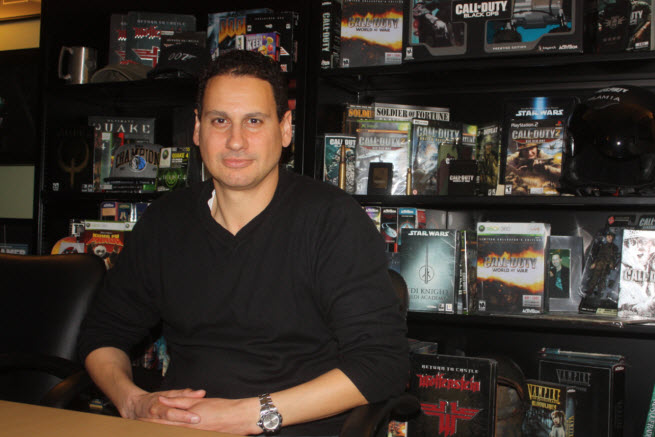Activision Blizzard is announcing today that Call of Duty: Black Ops II will be the newest installment of the fastest-selling video game franchise of all time. Once again, studio Treyarch will make this game, which has more than 250 developers (plus another 50 outside) working on the title for its fall release.
Call of Duty has generated billions of dollars in revenues since 2003, and the latest installments are generating more than $1 billion in revenues each year. While Call of Duty creators Infinity Ward have overshadowed Treyarch in the past, Treyarch has become an equal partner in producing a new Call of Duty game every other year.
The previous Black Ops title took us back to the secret operations of the 1960s. The new game will take place in both the 1980s and the year 2025. That’s a huge change for the franchise in terms of storyline and combat tactics. In the game, terrorists hijack the U.S. military’s fleet of drones and use them against major cities in the U.S. and China.
We talked with Mark Lamia, studio head of Treyarch, about this change in the setting for the game and the challenge of designing it. Here’s an edited transcript of our interview. And check out our interview with Lamia from two years ago.
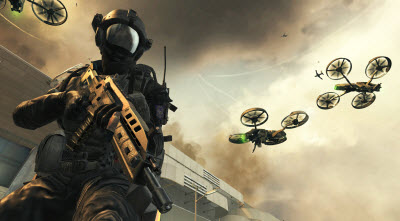 GamesBeat: How did you get started on the concepts for Call of Duty: Black Ops II?
GamesBeat: How did you get started on the concepts for Call of Duty: Black Ops II?
Mark Lamia: It came toward the very end of Black Ops. I think it was around submission. Dave Anthony [game design director at Treyarch] and screenwriter David Goyer had a conversation about working together. We wanted to create a sequel. What would that be? Dave [Anthony] has made quite a few Call of Dutys, and this time he really wanted to rewrite the rules of storytelling. We talked about doing this generation-spanning Call of Duty: Black Ops.
While the first one took place mostly during the Cold War, there was one level in that post-World War II era. As part of our fiction, we don’t focus on a time frame. It’s all about black ops. That really allows us to take on whatever fiction we want to tell. So in this case it was — we knew we wanted to introduce new gameplay. And we felt like that near-future setting would provide some really good fertile ground for us to create new gameplay with new weaponry and new technology available at the time.
That’s where that all started. It started on the story front but also from the gameplay perspective, looking at it on both sides. I think it’s really important, especially since you can’t just think about the campaign. You have to think about multiplayer. We wanted to introduce new gameplay there. Having some of the new technology would allow some of the new gameplay. And if you look at what the campaigns in the past — they have really introduced a lot of new gameplay that you can experience. I say you “can” experience it because you don’t have to, like in the Strike Force missions. You could just play that with a gun in your hand. You don’t have to take over any of the tools of the battlefield, like the drones or commanders. But you’d be missing a lot of the fun if that’s all you did.
GamesBeat: How long ago did you also decide to go down different fictional lines between Treyarch and Infinity Ward? This seems like the story almost means that you’re on a completely separate story arc than Modern Warfare.
Lamia: Yeah, the two timelines have never intersected. They’re in the same franchise, but they’re different fictions inside the same franchise.
GamesBeat: I didn’t really realize that with the first Black Ops.
Lamia: Oh, really?
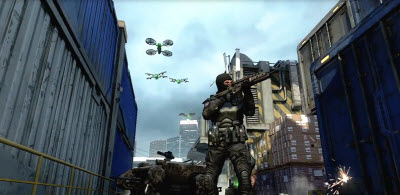 GamesBeat: I thought that Black Ops is the ’60s, Modern Warfare is in the present time, but they all could be in the same timeline. And so if your story is now moving to 2025, that creates a problem. If you visit New York in your story, and it is still standing, then that means that the city wasn’t destroyed in Modern Warfare 3. But that’s never been the way you guys have thought about it?
GamesBeat: I thought that Black Ops is the ’60s, Modern Warfare is in the present time, but they all could be in the same timeline. And so if your story is now moving to 2025, that creates a problem. If you visit New York in your story, and it is still standing, then that means that the city wasn’t destroyed in Modern Warfare 3. But that’s never been the way you guys have thought about it?
Lamia: No, no, actually. Like I said, when we think about the fictions, we actually created a historical fiction for Black Ops that assumed we were where we were — that these were the black ops. If you remember, our story was that everything you know about history is wrong. Those are the secret wars — the deniable operations you didn’t know about.
That’s the case as we’re crafting the ’80s as well. So when you experience those conflicts in the ’80s, some of those conflicts that you have heard about might be different. They’ll set you in that historical setting, but we’ll weave our fiction right into it. There will be a lot of interesting surprises for the player in the story much like there was with the original Black Ops. That was really interesting. One of the new interesting challenges for us is we don’t know what the future holds, so we actually had to create it. We knew that we wanted it to feel very rooted in fact if someone were to research it. This is a very well-researched and thought-through fiction for a future story. We’re creating that second Cold War.
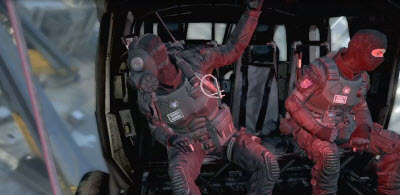 GamesBeat: It seems like this new timeline allows you to create cool new weapons. With the 1960s or 1970s, you were limited to the technology of the time. That’s why you couldn’t use drones in the first game, right?
GamesBeat: It seems like this new timeline allows you to create cool new weapons. With the 1960s or 1970s, you were limited to the technology of the time. That’s why you couldn’t use drones in the first game, right?
Lamia: They are black ops. So they did have some pretty different kinds of weapons that nobody during those days would have heard about. They did have technology and advancements. But we didn’t have any real drones. We did have a TV-guided missile in Black Ops in both campaign and the multiplayer. We did have a radio-controlled (RC) car. It is fictional, and the fiction is that these guys have access to technology that other people don’t and that people may not even know about. We never tried to push it into drones in the past, if you know what I mean, but with that kind of setup and fiction, that’s what we’re using this future fiction for.
GamesBeat: I guess the advantage of going into the future is that you’re free to use anything, right? You can create all these brand-new weapons. That seems to be what the fan base really loves, right? If you went back to 1900 or so, they’d lose their submachine guns, and they’d be very unhappy about that.
Lamia: What it has done is it has allowed us, inside of a plausible fiction, to set up certain kinds of technologies. But we don’t do just anything. Every single weapon that we created, the team has thought about and thought about if it were plausible to have the technology for that weapon or that attachment given the coming decade or beyond a decade.
The goal for us was to come up with new and fresh gameplay that people hadn’t yet had an opportunity to experience. And so, going to a time frame helps with that, especially since we wanted to have it rooted in fact. I guess that is really the challenge, right? The future hasn’t happened. Making new gameplay and things that people haven’t seen in a period in history which hasn’t happened yet — that’s the challenge. But that’s also the fun of it.
GamesBeat: It sounds like there’s just an enormous amount of free thinking here. Were there any limitations you felt on what you should or could do given that this is part of a series as well — that this is not the last game you’re going to make?
Lamia: I have no idea, to be honest with you. We’re focused on just making Black Ops II. We haven’t thought about what comes after it. Have there been any limitations? No. I think it was just the boundaries we gave ourselves. We gave ourselves some guidelines. It was plausible reality. We wanted it to feel grounded, and so in order to create that fiction, you impose your own.
But it’s a very gray area. What’s plausible to one person and to another person might be two totally different things. But there’s usually a pretty good argument presented internally here when we’re coming up with our stuff. We’ve iterated on things — things that we’ve tried have not felt right, and we’ve had to iterate on that. Getting that future fiction right has been a challenge.
 GamesBeat: Was any of it driven by the fans and the reaction to the first game? Sometimes people will remove things that wind up being unpopular for some reason or bring back things that everybody wants.
GamesBeat: Was any of it driven by the fans and the reaction to the first game? Sometimes people will remove things that wind up being unpopular for some reason or bring back things that everybody wants.
Lamia: We think the fans enjoyed the fiction of Black Ops and the characters that we introduced. I think that helped influence Dave’s decision to want to have them as part of this narrative fiction that he wanted to create with Black Ops II. You listen to your community and your fan base after you release a game, particularly your online community. They’re playing the game for many, many hours, a lot of them. There’s a lot of feedback that comes in, and we do try to pay attention to that.
But often times, what they’ll identify as their desires — you have to dig deeper to think about, well, what are they really saying here? Zombies is also very interactive with its fan base in terms of seeing what excites them and things like that. We’re definitely making the game that we want to make, but we’re also paying attention to the community. They’ve been very good to us. They’ve played a lot of Call of Duty games, and they’re interested in things we haven’t done yet. So I’m sure it’s have some influence on the team.
But what I like about Black Ops II is you’ll find that many people aren’t expecting us to have branched out and done everything from the fiction to the new gameplay that we’ve shown you here today. I think that’s going to be exciting and new for them.
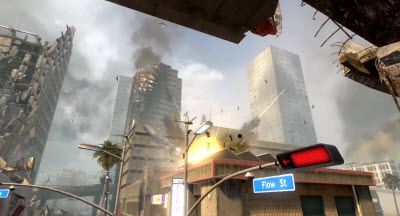 GamesBeat: Are you running out of major cities to visit and destroy?
GamesBeat: Are you running out of major cities to visit and destroy?
Lamia: Naaah, there’s plenty of places to go.
GamesBeat: Set it in Antarctica or something.
Lamia: We’ve actually gone there in Black Ops I, during the…the post in the Reznov mission — that’s right. When you first discovered the Nova gas. So we’ve even been to Antarctica.
We do like to do a variety of locations. I think that’s exciting for people; it’s exciting for our artists to be able to work with new environments. I’m sure you saw some of the art on the walls. There’s a lot of different kinds of environments and architecture. I think that’s pretty stimulating to the creative guys here, to be able to work on different locations — different sorts of things — whether it’s architecture or organic materials or whatever.
GamesBeat: Is there anything that would be consistent between what you do and what Infinity Ward does? Is there some understanding there that if it’s got the Call of Duty name on it, it’s going to have these certain characteristics?
Lamia: We do share some values that are similar. I think the desire to make sure, particularly, that the multiplayer game runs at 60 frames per second and is fast-paced and precise. The cinematic nature of the game, I think, is sort of signature for the series. For every game that we’ve made, or Infinity Ward or some of the other developers have made, that’s an important aspect of it.
 GamesBeat: Are you actually sharing stuff there, like the cinematics team or the engine itself?
GamesBeat: Are you actually sharing stuff there, like the cinematics team or the engine itself?
Lamia: Well, as you know, we’re part of Activision. We actually do open up anything from our side that they can have access to, but they have their own team with their own creative work. The way the parent company operates with the studios is it lets them take the lead on their own creative work. Whether it’s inside of the Call of Duty franchise or, frankly, some other area of essential technology or whatever other area — if there are things that teams can access or leverage, then they do.
For example, the facial rig and the performance capture was something that we worked with Activision’s central technology team on quite a bit. There’s a lot of learnings there that can be applied to other teams. That’s a pretty good example right there.
GamesBeat: So the graphics look surprisingly good to me.
Lamia: Oh, good. Thank you.
GamesBeat: The faces as well — the animations there. I would have thought it might require a next generation before you could make more improvements. [laughter]
Lamia: Write it! Right there, write that! The team worked really hard to make that art.
GamesBeat: Did it surprise you as well that you could get more out of the 360 or out of the PS3 here?
Lamia: Did it surprise us? I have to say that I was really happy when they showed me the team’s efforts on the prototyping. I was very happy with what they’d done. Surprised? I think, you know, given the team’s experience, as we spent more and more time in this engine — some of these graphics engineers have been working in this generation of technology now ever since before it even launched because they were on launched titles. So I guess it’s not entirely surprising.
But I was amazed at what they were able to do. They have done some amazing work in this generation of technology if you think about it. They set a really ambitious goal with this one; to say that they’re going to get a piece of hardware to look — through both graphics and techniques on the artists’ side — to look like an advanced PC and keep this game running at 60 frames per second was a really challenging goal. And I’m really happy with the results.
GamesBeat: Is it the same strategy to make it the same across the PS3, Xbox, and PC?
Lamia: The game is the same. The game experience is the same on the Xbox, the PS3, and the PC, yeah. The PC will, however, will have things like DX11 hardware support, which will support things that this current generation of console hardware can’t do. There are things like monitor resolution, where you’re going to get details with more memory that you just don’t have on the resolution of TV screens. So you’ll be able to get those. But the games themselves will be the same on all platforms.
GamesBeat: I guess the way I absorbed all of that was that you could create more effects, like either the dust or the smoke or the particles, you could do a lot more of that in the same view in the same scene, right?
Lamia: That’s right.
GamesBeat: A lot more things happening all in the same space.
Lamia: Yeah, I think you could do more of it. Hopefully this came through. Really, the challenge is not that we couldn’t do some of this stuff. It’s that we couldn’t do it and maintain that map playing at 60 frames per second. That is the tricky part.
It’s not like we just started working on it. We could have done the kind of lighting techniques that we did before, but we would have then had to compromise the frames per second. There are all kinds of trade-offs you always make when you’re trying to do that. It is the challenge of being an interactive artist and engineer. We don’t get to render things out to a fixed piece of media.
It doesn’t matter how detailed and complex it is. These guys can detail all day long. I think what’s amazing is that they can detail it to that level of detail and have it running in real-time on that piece of hardware. That’s, I think, the trick. And so if a reaction is like yours, where people are thinking, “Wow, I didn’t think I was going to get that until the next generation,” that’s awesome. That’s a very high compliment for the team.
GamesBeat: One of my concerns in multiplayer would be that some of those guns we saw would be too good to use. You would dominate the field.
Lamia: So you’re talking about balance now. You’re talking about balance….
GamesBeat: Shooting through barriers — cement barriers or whatever. That looks like some people could really go to town on people like me.
Lamia: So are you a camper? Are you serious? You’re a camper! Some would argue that your play style is not the fair play style. I think it’s all about balance; it’s all about trade-offs. Dave has to engineer enough tuneables in there to balance it, but also, one of his goals is to ensure that there are enough counter-play styles to all the different kinds of play styles.
He’s very experienced. He has made a lot of Call of Duty games. People comment that they like how Black Ops feels. There’s a good gunfight that’s going on in the multiplayer. So I’m really confident in David’s ability to handle the technology and balance that properly.
 GamesBeat: I suppose you could beef up your armor if you’re also more vulnerable.
GamesBeat: I suppose you could beef up your armor if you’re also more vulnerable.
Lamia: I’m not going into that yet. I can’t go into multiplayer.
GamesBeat: But the one I thing I wonder how you handle is the 1980s weapons going against 2025 weapons.
Lamia: The multiplayer takes place exclusively in the year 2025.
GamesBeat: Okay.
Lamia: Without getting into weapons…that’s not to say that certain weapons could be around for a while. There are weapons right now that have been around for a while. You never know.
GamesBeat: Or the RC car bomb. When did the RC car bomb appear?
Treyarch PR: You talk about balance — the responsibility of balance. You talk about the graphical updates. One thing that I’ve taken away from these meetings is talking about your team, bringing it from three separate teams to one team for Black Ops, and then you guys have been working together for a long time now. That’s one solid team now.
Lamia: Yeah. I mean, you just look at this wall here behind me [see picture at top of story]. I think it’s really important to note that when we made World at War, there were three teams here working on three different games: Quantum of Solace, World at War, and Spider-Man: Web of Shadows.
You wrote a very kind article. You enjoyed what we showed you with Black Ops. I remember you talking about our team when you wrote that article a couple of years ago, and you recognized what we were creating with Black Ops very early on.
While it was a team that was filled with Call of Duty veterans, as a team, that was a new team. That was a team that came together from multiple teams when we said, “We’re just gonna make Call of Duty here at Treyarch. We’re going to put all of our attention, energy, and focus into one place and we’re going to give it everything we’ve got.” That’s what Black Ops was.
When you put together multiple teams, it takes a little while for everything to be clicking and working, right? There are leads from multiple teams; there are people who are familiar with different tools even — maybe even different genres — and yet very talented. So it’s not surprising to me that you see this team, by the way, doing new things. Because there are influences coming from people who were working even in different genres.
We have a super-talented artist who’s been at Treyarch for a long time who I remember — on Spider-Man 3 — looking at the street textures in New York or the sides of the buildings. He would sit there and look at the sides of the buildings and analyze it. And I remember walking up to him when they were working on that Los Angeles — the destroyed Los Angeles landscape. He was looking at the destruction on the building, and I just looked at it, and I said, “My God, it’s deja vu.”
Anyway, it was three teams, and it took us the better part of that first year of Black Ops to get to the place where everyone could really get the most out of each other. It was really that second year where we hit our stride.
You’ve probably worked at different companies and things like that. You know that when there’s a leadership change or there’s a structure change, there’s a little bit of time where you’re all getting familiar — how to get the most out of each other and get the best out of each other. It’s very natural, especially in a creative space, for that. By that second year, we had that humming here. That’s why coming out of Black Ops, we put everything we had into Black Ops II.
Now, from this point, what can we do? If you look at it from that perspective, it’s probably not that surprising that the team wanted to do all these different things. They had such a great head of steam coming out of Black Ops.
GamesBeat: How many people worked on this one?
Lamia: There’s over 250 people at Treyarch, but there’s over 300 people working on the project. We do have contractors and test teams that aren’t part of the company. Those others aren’t actually employees of Treyarch. But there’s over 300 people working on the game right now.
But if you think about it, the campaign’s pretty big and ambitious. The multiplayer is pretty big and ambitious. And they really are creating another game with the Zombies there.
Check out our other coverage of Call of Duty: Black Ops II:
- First trailer released
- Treyarch unveils Black Ops II, a.k.a. Attack of the Drones
- It’s not the same old 3D graphics
- How Treyarch created realistic human faces
- Creating the sounds of future wars
![]() GamesBeat 2012 is VentureBeat’s fourth annual conference on disruption in the video game market. This year we’re calling on speakers from the hottest mobile, social, PC, and console companies to debate new ways to stay on pace with changing consumer tastes and platforms. Join 500+ execs, investors, analysts, entrepreneurs, and press as we explore the gaming industry’s latest trends and newest monetization opportunities. The event takes place July 10-11 in San Francisco, and you can get your early-bird tickets here.
GamesBeat 2012 is VentureBeat’s fourth annual conference on disruption in the video game market. This year we’re calling on speakers from the hottest mobile, social, PC, and console companies to debate new ways to stay on pace with changing consumer tastes and platforms. Join 500+ execs, investors, analysts, entrepreneurs, and press as we explore the gaming industry’s latest trends and newest monetization opportunities. The event takes place July 10-11 in San Francisco, and you can get your early-bird tickets here.
VentureBeat's mission is to be a digital town square for technical decision-makers to gain knowledge about transformative enterprise technology and transact. Learn More
